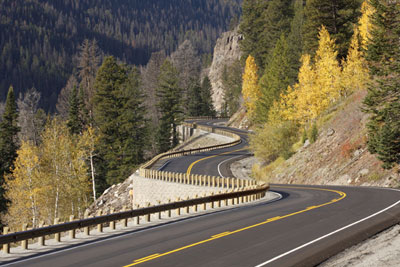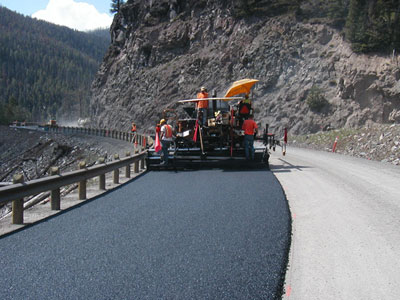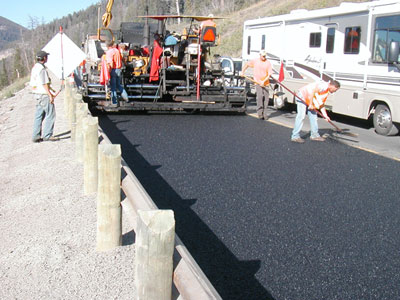U.S. Department of Transportation
Federal Highway Administration
1200 New Jersey Avenue, SE
Washington, DC 20590
202-366-4000
Focus
| Accelerating Infrastructure Innovations |
Publication Number: FHWA-HRT-08-012
Date: April 2008
The successful deployment of warm-mix asphalt on roadways in Yellowstone National Park in August 2007 provided valuable experience in using this environmentally beneficial technology for the Federal Highway Administration's (FHWA) Federal Lands Highway (FLH) division and representatives from State and local transportation agencies, contractors, the National Park Service, and other organizations. "The project allowed Federal Lands to evaluate the viability of the technology as a standard construction practice for Federal Lands projects," says Brad Neitzke, FLH Materials Engineer at FHWA.
Mix production for warm-mix asphalt can typically be done at temperatures of 10 °C (50 °F) to 37 °C (100 °F) below the standard hot-mix temperatures of 149 °C (300 °F) to 176 °C (350 °F), reducing air emissions and fuel consumption. Another benefit is improved workability of the mix, resulting in easier compaction. FHWA identified warm-mix asphalt as a promising technology based on its 2007 International Scan on Warm-Mix Asphalt, which was cosponsored by the American Association of State Highway and Transportation Officials and the National CooperativeHighway Research Program.
| "This was the first time warm-mix asphalt had been used in Yellowstone, and the process went very well." |
FLH laid 28,000 metric tons (30,864 tons) of asphalt on 11.2 km (7 mi) of the East Entrance Road to Yellowstone National Park in Wyoming, starting on August 21, 2007. The asphalt was placed in two equal lifts, for a total pavement depth of 100 mm (4 in). Advera was used as a warm-mix additive for 8,164 metric tons (9,000 tons) of asphalt, while 6,804 metric tons (7,500 tons) used Sasobit as the warm-mix additive. The remaining section was constructed as a control section using traditional hot-mix asphalt. "This was the first time warm-mix asphalt had been used in Yellowstone, and the process went very well," says Neitzke. "Both the contractor and Federal Lands were very pleased with the outcome. We were able to drop the temperature down to 250 degrees Fahrenheit and achieved the proper density with minimum impact." Benefits included the contractor saving 20 percent in fuel costs at the asphalt plant. While the overall cost of the warm-mix asphalt was a little higher than a conventional mix, contractors may realize more savings with increased plant output. The reduced compaction effort needed can also lower costs.
 |
| A section of the East Entrance Road to Yellowstone National Park in Wyoming was paved in August 2007 using warm-mix asphalt. |
 |
 |
| Warm-mix asphalt is placed on Yellowstone's East Entrance Road. The asphalt handled similarly to a conventional mix. |
Neitzke notes that the warm-mix asphalt handled similarly to a conventional mix, with workers reporting no handling difficulties. The warm-mix additives did not affect the mix design, and nor was moisture sensitivity an issue. In an important environmental benefit, the paving was accomplished without the warm-mix asphalt generating any smoke.
FLH offered two onsite opportunities to view the project, with nearly 30 representatives from 12 State, local, and Federal agencies and contractors attending. "We wanted people to come out and see the technology," says Neitzke.
FLH is currently monitoring performance data for the project, with more testing to be done on such variables as volumetrics and rutting. The Western Research Institute in Laramie, Wyoming, is also reviewing the project data, while FHWA's Mobile Asphalt Lab staff is evaluating results from a suite of tests performed at the project site. While FLH does not yet have any warm-mix asphalt work planned, it is seeking to use this technology on more projects to help further define the benefits of warm-mix technology.
For more information about the Yellowstone warm-mix asphalt paving project, contact Brad Neitzke at FHWA, 360-619-7725 (email: brad.neitzke@fhwa.dot.gov). To learn more about warm-mix asphalt, visit www.fhwa.dot.gov/pavement/asphalt/wma.cfm. The International Scan report is available online at http://international.fhwa.dot.gov.